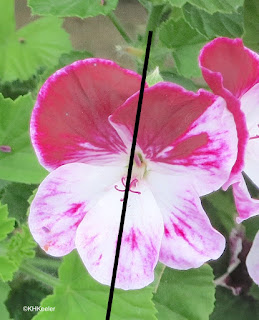 |
| geranium, genus Pelargonium |
That made wild geraniums relatively easy to identify. There are native species all over North America, fun to spot on a hike.
 |
| geraniums, genus Geranium |
The common and scientific names are confused. The geraniums Jefferson planted were native to South Africa. Originally included in the genus Geranium (in the plant family named after them, Geranicaceae), the South African plants were given their own genus, Pelargonium in 1789 just three years after Jefferson introduced them to the U.S. But the common name geranium stuck.
 |
| geraniums or cranesbills, genus Geranium |
In the United States if it "looks like a geranium" it is likely Geranium or Pelargonium. For geraniums, you can tell plants in the genus Geranium from Pelargonium because those of Geranium have five very similar petals and are radially symmetrical, while the two upper petals of Pelargonium look different from the three lower ones and so the flowers are symmetrical only along single line. (Symmetry is a very useful flower characteristic: radially symmetrical is called actinomorphic, bilaterally symmetrical zygomorphic. Lots of details of flower interaction with pollinators begin with the symmetry of the flower.) Cultivated doubles are likely Pelargonium. In addition, if it is a winter-hardy perennial, it is a Geranium because Pelargonium plants are killed by frost.
Of the four other genera in the geranium family, you might encounter an Erodium, called storksbill, cranesbill or filaree as two or three of the 80 species of Erodium are weeds in the U.S. and one, Erodium texanum, is native to the U.S. southwest. The remaining genera are not found in the United States except for a rare native, California macrophylla, called Erodium macrophylla by the USDA.
 |
| geranium or cranesbill, genus Geranium Radial symmetry means the plant is symmetrical along each of those lines |
 |
| geranium, genus Pelargonium Only a single plane of symmetry, the one drawn |
Watch for wild geraniums, genus Geranium. North America has fourteen native Geranium species with wide enough distributions that you might spot one anywhere (USDA link).
The cranesbill name is descriptive. Plants in the geranium family have distinctive seed pods which were seen as looking like a crane's bill. Storksbill, another version of that description, is another common name for geranium family plants.
 |
| The crane's bill-shaped seed pods. |
The flowers attract numerous interesting pollinators. Note the lines on the flowers. Those are nectar guides, acting like arrows "this way to the nectar."
 |
| wild geranium genus Geranium probably Geranium richardsonii, Rocky Mountain National Park 2016 |
I called the native North American geraniums I've seen all "wild geranium" but of course, depending on where you are your wild geranium with be properly called spotted geranium (link) or piney woods geranium (link) or maybe Carolina geranium (link).
Notice wild geraniums, maybe work out their exact name, but best of all, enjoy seeing them.
Comments and corrections welcome.
Miscellaneous sources
Aedo, C. 2001. Taxonomic revision of Geranium sect. Brasiliensis (Geraniaceae). Systematic Botany 28 (2): 205-215.
Crook, J. 2013. A short history of the geranium. Mygardengeek.com link Accessed 2/22/19
Evangelista, D., S. Hotton and J. Dumais. 2011. The mechanics of explosive dispersal and self-burial in the seeds of the filaree, Erodium cicutarium (Geraniaceae). Journal of Experimental Biology. 214: 521-529.
Aldasoro, J., C. Navarro, P. Vargas, L. Sáez and C. Aedo. 2002. California, a new genus of Geraniaceae endemic to the southwest of North America. Anales Jard. Bot. Madrid. 59 (2): 209-216.
Stevens, P. F. (2001 onwards). Angiosperm Phylogeny Website. Version 14, July 2017 [and more or less continuously updated since]." http://www.mobot.org/MOBOT/research/APweb/. Accessed 2/22/19.
Kathy Keeler, A Wandering Botanist
More at awanderingbotanist.com




No comments:
Post a Comment